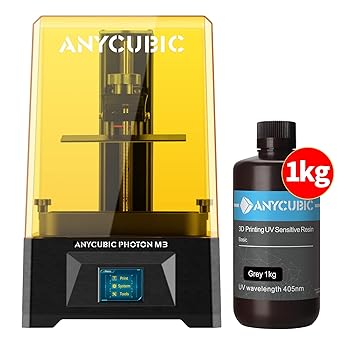Page Contents
Details: ANYCUBIC Photon M3 Resin 3D Printer + ANYCUBIC 3D Printer Resin (Grey, 1kg)
Brand: ANYCUBIC
Instructions for use(1) Before use:Shake the liquid resin before use;Clean the resin tank and the molding platform to keep the bottom of the resin tank in light transmission.(2) When using:Unscrew the cap and add it to the resin tank according to the equipment requirements;Select the correct print parameters and settings for printing.(3) After use:After printing, please use the matching tools for post-processing, including blade, diagonal pliers, tweezers, containers, gloves; ethanol (≥95%), lactate or isopropyl alcohol cleaning solution; (4) Post-processing steps:A. Remove the printed model from the molding platform with a blade;B, Submerge the model in the cleaning solution, rinsed or ultrasonically washed, then taken out and drained; ANYCUBIC Wash and Cure machines are suggested to ensure better effect. C. Proper processing, such as removing support, polishing, coloring, etc.
Advantages
- Products can be returned
- Make sure this fits by entering your model number.
- ANYCUBIC Resin 3D Printer, 7.6″ Photon M3 LCD SLA UV 3D Resin Printer with 4K+ Monochrome Screen, Protective Film, Fast Printing, Max Printing Size 7.08″ × 6.45″ × 4.03″
- ANYCUBIC 3D Printer Resin, 405nm SLA UV-Curing Resin with High Precision and Quick Curing & Excellent Fluidity for LCD 3D Printing (Grey, 1kg)
Notice
- Is an online purchase
- Delivery may be delayed in some areas.
Buyer Guide 3D Printers
A 3D printer is a machine that allows you to create three-dimensional objects from a digital file or from a 3D model.- Price. The price ranges from $300 for an entry-level printer to $5,000 for an industrial printer.
- Print Speed. The print speed is the amount of time it takes to print a 3D object. The print speed varies with the printer model, but the average is 0.2 to 0.4 seconds per layer.
- Resolution. The resolution is the number of points per inch (PPI). The higher the resolution, the more detailed the 3D object will be. The higher the resolution, the more detailed the 3D object will be.
- Nozzle size. The nozzle size indicates the size of the nozzle used. The nozzle size on entry-level printers is 0.4 mm and goes to 0.3 mm on professional printers.
- Materials. There are many types of 3D prints. The most common is PLA, which is approved by the ABS standards.
- Filament. The filament is the material that goes into the nozzle of the printer. The filament comes in various colors and is typically sold in 1.75-gallon spools.
How to choose 3D Printers
When shopping for a 3D printer, there are a couple of key factors to keep in mind:- How easy is the 3D printer to use? Buying a 3D printer can be intimidating, particularly if you’re not familiar with how it works. When choosing a printer, look for one that has a clear instruction manual, as well as clear and detailed guides online. Also, consider whether the 3D printer comes with software or is compatible with other platforms.
- Does the 3D printer work right? 3D printers aren’t cheap. Before you buy a 3D printer, it’s important to test it out and make sure it works right. Most 3D printers come with either an SD card or a USB flash drive, so it’s a good idea to download and test the 3D printer’s software before committing to the purchase.
How to maintain 3D Printers
3D printing is a remarkable way to create complex, functional objects. However, 3D printing is also incredibly time-consuming, complicated, and expensive.Because of this, many 3D printers require regular maintenance. For instance, most 3D printers have a nozzle, which can get clogged with debris over time.
These clogs can slow down your prints, cause jams and errors, and ruin the quality of your 3D creations.
There are countless tutorials and guides on how to unclog a 3D printer’s nozzle. However, many of these guides require expensive replacement parts or professional equipment.
Luckily, there are several ways to clean your 3D printer’s nozzle without purchasing expensive replacement parts. Some of the most common ways to clean a 3D printer’s nozzle are:
- Cleaning the nozzle with alcohol.
- Cleaning the nozzle with dish soap.
- Installing a UV lamp.
- Cleaning the nozzle with a toothbrush.
- Using a rotating brush.
- Using compressed air to blow away debris.




